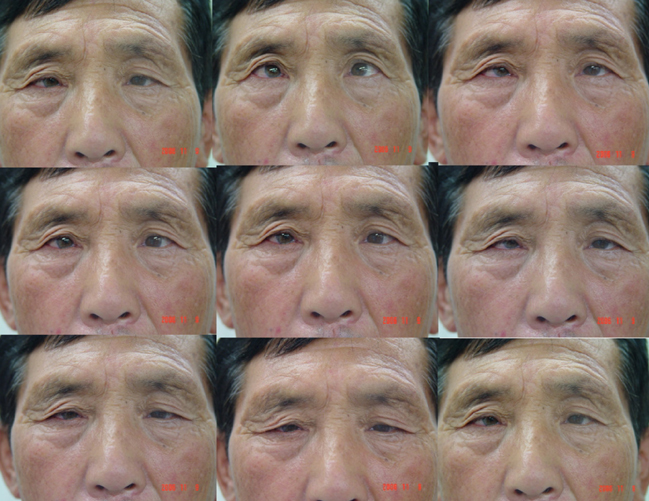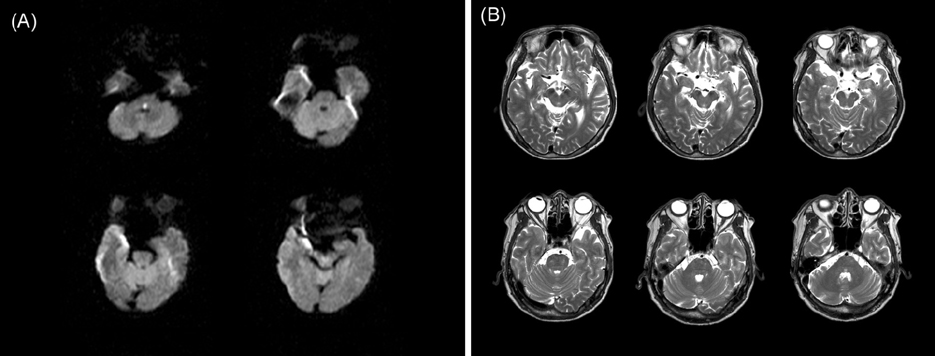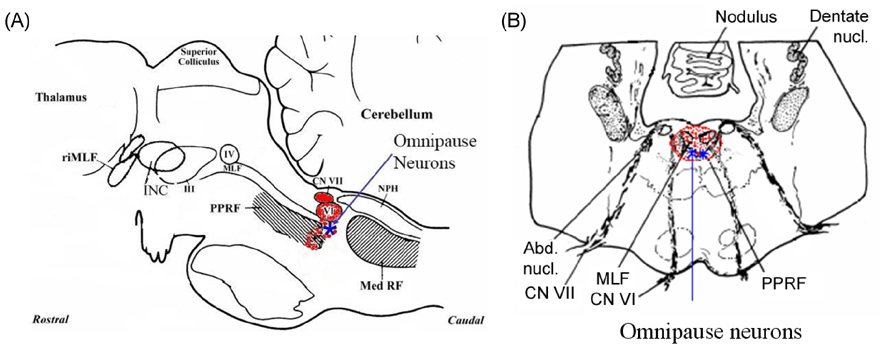J Clin Neurol.
2007 Dec;3(4):208-211. 10.3988/jcn.2007.3.4.208.
A Small Dorsal Pontine Infarction Presenting with Total Gaze Palsy Including Vertical Saccades and Pursuit
- Affiliations
-
- 1Department of Neurology, Asan Medical Center, University of Ulsan College of Medicine, Korea. sukwon@amc.seoul.kr
- 2Department of Neurology, Seoul National University, Bundang Hospital, Korea.
- KMID: 1808561
- DOI: http://doi.org/10.3988/jcn.2007.3.4.208
Abstract
- A small localized infarction in the dorsal pontine area can cause various eye-movement disturbances, such as abducens palsy, horizontal conjugate gaze palsy, internuclear ophthalmoplegia, and one-and-a-half syndrome. However, complete loss of vertical saccades and pursuit with horizontal gaze palsy has not been reported previously in a patient with a small pontine lesion. We report a 67-year-old man with a small dorsal caudal pontine infarct who exhibited total horizontal gaze palsy as well as loss of vertical saccades and pursuit.
Figure
Reference
-
1. Leigh RJ, Zee DS. The neurology of eye movements. 2006. Fourth edn. New York: Oxford University Press.2. Pierrot-Deseilligny C, Goasguen J. Isolated abducens nucleus damage due to histiocytosis X. Electro-oculographic analysis and physiological deductions. Brain. 1984. 107:1019–1032.
Article3. Gamlin PD, Gnadt JW, Mays LE. Lidocaine-induced unilateral internuclear ophthalmoplegia: effects on convertgence and conjugate eye movements. J Neurophysiol. 1989. 62:82–95.
Article4. Hanson MR, Hamid MA, Tomsak RL, Chou SS, Leigh RJ. Selective saccadic palsy caused by pontine lesions: clinical, physiological, and pathological correlations. Ann Neurol. 1986. 20:209–217.
Article5. Slavin ML. A clinicoradiographic correlation of bilateral horizontal gaze palsy and slowed vertical saccades with midline dorsal pontine lesion on magnetic resonance imaging. Am J Ophthalmol. 1986. 101:118–120.
Article6. Kaneko CR. Effect of ibotenic acid lesions of the omnipause neurons on saccadic eye movements in rhesus macaques. J Neurophysiol. 1996. 75:2229–2242.
Article7. King WM, Lisberger SG, Fuchs AF. Responses of fibers in medial longitudinal fasciculus (MLF) of alert monkeys during horizontal and vertical conjugate eye movements evoked by vestibular or visual stimuli. J Neurophysiol. 1976. 39:1135–1149.
Article8. Cremer PD, Migliaccio AA, Halmagyi GM, Curthoys IS. Vestibulo-ocular reflex pathways in internuclear ophthalmoplegia. Ann Neurol. 1999. 45:529–533.
Article9. Willison HJ, Yuki N. Peripheral neuropathies and antiglycolipid antibodies. Brain. 2002. 125:2591–2625.
Article
- Full Text Links
- Actions
-
Cited
- CITED
-
- Close
- Share
- Similar articles
-
- ERRATUM: A Small Dorsal Pontine Infarction Presenting with Total Gaze Palsy Including Vertical Saccades and Pursuit
- A Case of Bilateral Horizontal Gaze Palsy due to Pontine Hemorrhage
- A Case of One and A Half Syndrome
- Pure motor hemiplegia with conjugate lateral gaze palsy in pontine lacunar infarction
- Neuro-Behcet's Disease Presenting with Foville Syndrome : A Case Report




